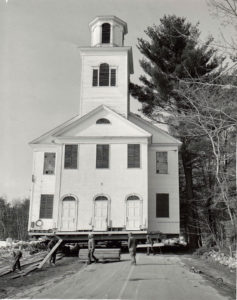By Elizabeth J. Normen
(c) Connecticut Explored Inc. Spring 2020
Subscribe/Buy the Issue!
In what must be one of my earliest memories, I can conjure an image of my childhood church in West Avon, built in 1818, before it was moved across the road in 1969 as part of much-needed renovations. Recent projects I’ve been involved in, including the Fall 2018 issue about the Constitution of 1818 and Venture Smith’s Colonial Connecticut, revived those early memories and reminded me that the Congregational church was integral to town formation in Connecticut in the colonial period. Two new church histories confirm this and show that there’s more to learn from surviving church records. As a bonus, these two books are loaded with drama.
A Tale of Two Meetinghouses & Their Communities: Avon, Connecticut 1746 – 2019 is the work of three local historians: Marjorie Bender, Nora Howard, and Jean Parker. The back-cover teaser suggests what’s in store for the reader: “In December 1817, the only church in Avon burned down, and it was probably arson.” By the winter of 1817, the authors explain, emotions were running high after years of disagreement about where to build a new meetinghouse. The fire led to a split. One faction built the West Avon Congregational Church in the geographic center of town. The following year, the surprise splinter group built the Avon Congregational Church in the commercial center of town (the northeast corner). The Avon church was listed on the National Register of Historic Places in 1972.
Historian and Florence Griswold Museum archivist Carolyn Wakeman’s Forgotten Voices: The Hidden History of a New England Meetinghouse (Wesleyan University Press, 2019) is the story of the 354-year-old First Congregational Church of Old Lyme. Wakeman draws on varied voices that tie the church’s history to “the religious belief, business, and family that linked Lyme with New Haven and Boston, New York and London, Barbados and China, the cotton-rich American South and the developing West.” Wakeman writes that she was surprised to encounter revelations—including those about slavery, adultery, and dismissal for abolitionist leanings—among the church’s ministers.
The church’s centrality to this small town is expressed by a parishioner’s letter to a family member after the fourth meetinghouse (built in 1815 after its predecessor went up in flames) was also destroyed by fire (again, suspected arson!) in 1907. The parishioner wrote, “Perhaps we loved it too much and thought more of the shell of our religion than we did of the kernel, but it was the symbol of everything that was best and had been best in the history of the town.” Forgotten Voices is a joint project of First Congregational Church and the Florence Griswold Museum and relates to the museum’s current exhibition Nothing More American: Immigration, Sanctuary, and Community, An Exhibition by Matthew Leifheit, which is on view through May 24. Learn more on page [xx].
When we drive by these early colonial churches, they can seem like clichés, predictable backdrops to a history we may not share or may no longer consider relevant. But in our increasingly secularized society, it’s worth re-appreciating both the beauty of these historic structures and the very human history they hold.
 Thank You!
Thank You!
Thank you to our loyal Friends of Connecticut Explored and to our new Friends! Your support is critical to our continued publication. Please see page 58 and our listing HERE.
This issue about historic preservation is supported in part by the State Historic Preservation Office of the Department of Economic and Community Development with funds from the Community Investment Act of the State of Connecticut. We thank SHPO for this support for educating our readers about the importance of historic preservation. Be sure to read Site Lines, which is also supported by these funds, in each issue.

